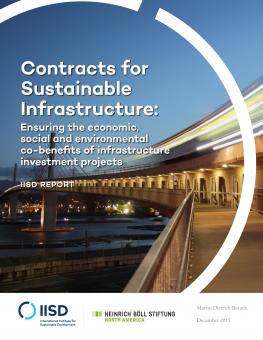
Contracts for Sustainable Infrastructure: Ensuring the economic, social and environmental co-benefits of infrastructure investment projects
This report defines sustainable infrastructure, outlines its expected characteristics and co-benefits, and presents why governments must and how they can integrate sustainability into public–private partnerships (PPP) and other infrastructure contracts.
Infrastructure—including transportation, electricity, telecommunications, water and sanitation—is essential to the achievement of the sustainable development goals (SDGs) and to the success of the Paris Agreement on Climate Change.
However, to achieve the SDGs and address climate change, the infrastructure to be upgraded and built must be sustainable—it must be specifically designed to mitigate economic, social and environmental risks, and to generate economic, social and environmental co-benefits.
Public–private partnerships (PPPs) are among the modes that government may adopt to structure infrastructure projects. The PPP contract forms a significant part of the normative framework governing the relationship between the government and the investor, allocating responsibilities and risks. For PPPs to lead to the development of sustainable infrastructure, governments and private parties must ensure that sustainability criteria are embedded in the project from its inception and appropriately reflected in the PPP contract.
The 2017 edition of the World Bank Group’s Guidance on PPP Contractual Provisions presents sample contract language that governments may adopt for PPPs. However, as pointed out by Foley Hoag LLP, the guidance frequently offers advice that restrains government measures aimed at achieving the SDGs, and misses an opportunity to consider how infrastructure projects can contribute to sustainable development.
Complementing the analysis by Foley Hoag LLP, this report seizes the opportunity missed by the World Bank Group’s guidance. Bridging IISD’s experience in public procurement and infrastructure finance and investment, it defines sustainable infrastructure, outlines its expected characteristics and co-benefits, and presents why governments must and how they can integrate sustainability into infrastructure contracts.
You might also be interested in
The Role of Multilateral Development Banks for Low-Carbon Procurement in the Infrastructure Sector
This report examines the critical role of multilateral development banks (MDBs) in advancing low-carbon procurement within the infrastructure sector.
Sustainable Asset Valuation (SAVi) of a Small-Scale Tree Planting Initiative in Côte d'Ivoire
This report analyzes the social, economic, and environmental outcomes of a small-scale tree planting initiative at schools in Côte d'Ivoire.
Green Public Procurement in India
This report analyzes the status of green public procurement (GPP) in India and suggests key strategies for advancing sustainable procurement practices.
Why the Energy Charter Treaty Modernization Doesn't Deliver for Climate
The Energy Charter Conference adopted the "modernized" Energy Charter Treaty (ECT) on December 3, 2024. IISD's Lukas Schaugg explains what the modernization does, when it will enter into force, its tension with EU law, and why the reformed ECT can still hinder climate policies.